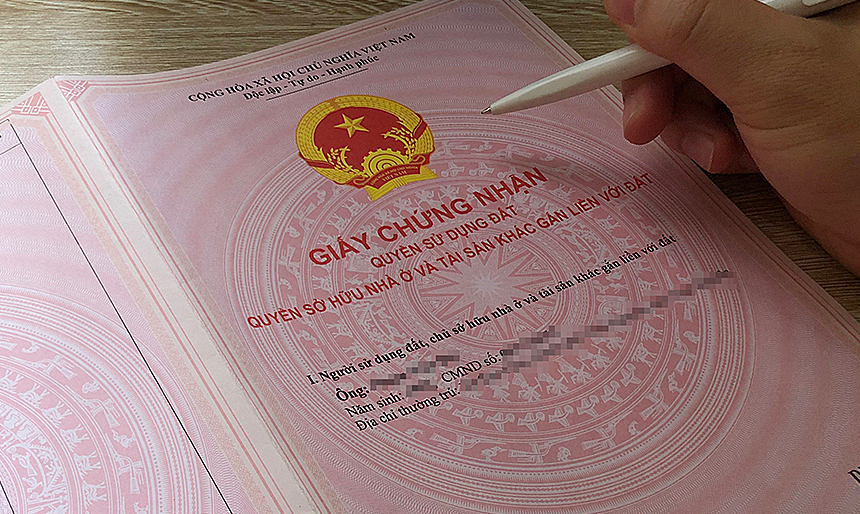Table of Contents
Joint purchase of land is a common practice for various purposes, including investment and property development. When purchasing land jointly, the ownership structure and legal implications are crucial considerations.
In the upcoming article by NT International Law Firm, we delve into the intricacies of joint land purchase, exploring the parties involved, ownership options, and the legal considerations that arise from shared ownership. Stay tuned to gain insights into this complex legal landscape and make informed decisions when embarking on joint land purchases.
In case of joint land purchase, whose name is in the Certificate?
In case of joint land purchase, whose name is in the Certificate? According to the 2013 Land Law, when multiple individuals share land use rights, houses, or other assets associated with a land parcel, the Certificate of Land Use Rights must include the full names of all land users. However, upon request of the land users, a single Certificate can be issued to a designated representative.
For individuals who jointly contribute funds to acquire a land parcel, if they mutually agree in writing to issue a single Certificate to a representative, the Certificate will be issued to that representative.
Important Note:
The request for a Certificate to be issued to a representative must be made through a notarized or authenticated document in accordance with the law (based on Clause 3, Article 5 of Circular 23/2014/TT-BTNMT of the Ministry of Natural Resources and Environment).

In case of joint land purchase, whose name is in the Certificate?
How the names are recorded in the Certificate
According to Clause 3, Article 5 of Circular 23/2014/TT-BTNMT, when a land parcel has multiple users or asset owners, the Certificate of Land Use Rights should be issued to each individual or entity after determining their respective land use rights and asset ownership.
Certificate Format for Shared Use and Ownership
Complete Issuance Information: Each Certificate should include the full information of the person to whom the Certificate is issued, as specified in Clause 1 of the Circular.
Shared Use and Ownership Notation: Following the issuance information, add the phrase “Shared use of land, shared ownership of assets attached to land (or Shared use of land or Shared ownership of assets) with…” followed by the names of the remaining individuals or entities sharing the same rights.
Certificate Issuance for Shared Use and Ownership with Representative
If there is a notarized or authenticated written agreement to issue a Certificate to a representative, the Certificate is issued to that representative. The Certificate should include the representative’s information as prescribed in Clause 1 of the Circular. Following the issuance information, add the phrase “Being the representative for people who use the same land (or own assets attached to the land or use the same land and joint ownership of assets attached to the land) including:… (list the names of individuals or entities jointly using land and assets attached to land).”
Handling Multiple Users or Asset Owners Not Listed on Page 1
If there are multiple users or asset owners not all recorded on page 1 of the Certificate, the last line of page 1 should state “and other people named in the Notes section of this Certificate.” Additionally, the Notes section should list the names of these individuals or entities.
By following these guidelines, land use rights and asset ownership information for shared land parcels can be accurately and comprehensively recorded on Certificates of Land Use Rights.

How the names are recorded in the Certificate
The rights and obligations of each member who share the common land use rights
The rights and obligations of each member who shares common land use rights based on point b, clause 2 of Article 167 of the 2013 Land Law:
Rights of Members with Shared Land Use Rights
1. Right to Use and Benefit from Land:
Each member has the right to use the land for its designated purpose and to enjoy the benefits derived from that use. This includes the right to cultivate crops, raise livestock, or construct buildings on the land in accordance with the agreed-upon terms of shared use.
2. Right to Participate in Decision-Making:
Each member has the right to participate in decision-making processes regarding the management and use of the common land. This includes voting on matters such as land allocation, resource utilization, and conflict resolution.
3. Right to Equitable Distribution of Benefits:
Each member has the right to an equitable share of the benefits generated from the use of the common land. This may include income from agricultural production, rental fees from structures on the land, or other forms of revenue derived from shared land use.
Obligations of Members with Shared Land Use Rights
1. Responsibility for Sustainable Land Use:
Each member has a responsibility to use the land in a sustainable manner, ensuring its long-term productivity and environmental integrity. This includes practices such as soil conservation, water management, and biodiversity preservation.
2. Obligation to Comply with Shared Use Agreements:
Each member must adhere to the terms of the shared land use agreement, which outlines the rights, obligations, and responsibilities of all members. This may include restrictions on land use activities, procedures for conflict resolution, and mechanisms for sharing benefits.
3. Duty to Contribute to Collective Maintenance:
Each member has a duty to contribute to the maintenance and upkeep of the common land. This may involve participating in communal labor, providing financial resources, or sharing in the costs of maintaining common infrastructure.
In summary, members of a shared land use arrangement have both rights and obligations that ensure equitable and sustainable utilization of the common land. These rights and obligations are essential for promoting cooperation, preventing conflicts, and maximizing the benefits derived from shared land use.

The rights and obligations of each member who share the common land use rights
Resolving Disagreements in Selling Common Land
In the context of shared land ownership, disagreements can arise when one or more joint owners disagree with the decision to sell the common land. While notarized consent from all joint owners is often assumed to be a requirement for selling common land, this is not always the case.
Article 167 of the 2013 Land Law provides the legal framework for addressing disagreements among joint owners regarding the sale of common land. Specifically, Point b, Clause 2 of Article 167 states that if one or more joint owners object to the transfer, donation, or inheritance of the common land, a separation of the land plot must be carried out to allow them to use their respective portions.
Resolving Disagreements When Selling Jointly Owned Land
When two or more individuals jointly own a piece of land and one person expresses a desire to sell, but the other(s) disagree, there are legal provisions in place to address this situation.
Requirement for Consent
Ordinarily, transferring, donating, or mortgaging common land use rights requires the notarized or authenticated consent of all joint owners. This ensures that all parties involved have a say in significant decisions regarding the shared property.
Separation of Land Upon Disagreement
However, in cases where one or more joint owners object to the sale, Point b, Clause 2, Article 167 of the 2013 Land Law provides an alternative solution. The land plot can be divided, allowing the joint owner who wishes to sell to transfer their individual portion.
Legal Basis for Separation
The right to separate a land plot for transfer is based on the principle that each joint owner has the right to exercise their individual rights over their portion of the land. This right is further reinforced by Article 128 of the 2015 Civil Code, which empowers joint owners to dispose of their share of ownership.
Conditions for Separation
To be eligible for separation, the land must meet certain conditions, such as having sufficient area to be divided into individual parcels without compromising the overall value or functionality of the property.
Sale of Ownership Rights
If separation is not feasible due to insufficient land area, the joint owner who wishes to sell may proceed to sell their ownership rights to another person. However, this process is subject to certain restrictions:
Notification to Other Joint Owners: The joint owner intending to sell must provide written notice to the other joint owners within three months for real estate and one month for movable property.
Priority Purchase Right: The other joint owners have the right of first refusal to purchase the ownership rights before the seller can offer them to a third party.
Equal Terms for All Buyers: The selling price and conditions offered to other joint owners must be the same as those offered to any third-party buyer.
These provisions aim to ensure fairness and protect the rights of all joint owners in the disposal of common property.
Conclusion
Navigating disagreements regarding the sale of jointly owned land requires understanding the applicable legal provisions and seeking guidance from legal professionals. The process of separation or sale of ownership rights must adhere to the established legal framework to protect the interests of all parties involved.

Resolving Disagreements When Selling Jointly Owned Land
Separation of Plots in Cases of Joint Land Purchase
Joint land purchase, also known as co-ownership, is an arrangement where two or more individuals or entities acquire a land parcel together. In this arrangement, the ownership rights are shared among the parties, and they hold a joint interest in the property.
When the parties involved in a joint land purchase decide to divide the plot, the division is typically determined based on their respective capital contributions. This means that each party’s share of the land corresponds to the proportion of capital they invested in the purchase.
To legally separate a plot in a joint land purchase scenario, the parties must adhere to specific legal requirements. Decree 43/2014/ND-CP, a Vietnamese government regulation, outlines the minimum area permissible for plot separation in various provinces and centrally run cities. This minimum area requirement ensures that the resulting plots maintain their viability and functionality.
NT International Law Firm has addressed the question of whose name is in the Certificate when purchasing land jointly. If you have any further questions or concerns regarding land or real estate, please contact our law firm immediately for expert legal advice.
If you require any legal assistance, please feel free to reach out to us via phone at 090 252 4567 or through email: info@ntpartnerlawfirm.com. At NT INTERNATIONAL LAW FIRM, our team is committed to offering you prompt and personalized advice.
You also might be interested in: The 2013 Law on Land
“The article’s content refers to the regulations that were applicable at the time of its creation and is intended solely for reference purposes. To obtain accurate information, it is advisable to seek the guidance of a consulting lawyer.”

LEGAL CONSULTING SERVICES
090.252.4567NT INTERNATIONAL LAW FIRM
- Email: info@ntpartnerlawfirm.com – luatsu.toannguyen@gmail.com
- Phone: 090 252 4567
- Address: B23 Nam Long Residential Area, Phu Thuan Ward, District 7, Ho Chi Minh City, Vietnam
